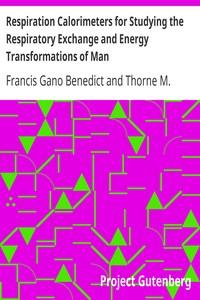Read this ebook for free! No credit card needed, absolutely nothing to pay.
Words: 22734 in 6 pages
This is an ebook sharing website. You can read the uploaded ebooks for free here. No credit cards needed, nothing to pay. If you want to own a digital copy of the ebook, or want to read offline with your favorite ebook-reader, then you can choose to buy and download the ebook.


: Respiration Calorimeters for Studying the Respiratory Exchange and Energy Transformations of Man by Benedict Francis Gano Carpenter Thorne M Thorne Martin - Physiological apparatus; Respiration; Animal heat; Metabolism Physiology
unnecessary to lower the glass door to the balance case or, indeed, to close the two doors to the compartment in which the elevator is closed, as the slight air-currents do not affect the accuracy of the weighing when only 0.1 gram sensitiveness is required.
PURIFICATION OF THE AIR-CURRENT WITH SODIUM BICARBONATE.
As is to be expected, the passage of so large a volume of air through the sulphuric acid in such a relatively small space results in a slight acid odor in the air-current leaving this absorber. The amount of material thus leaving the absorber is not weighable, as has been shown by repeated tests, but nevertheless there is a sufficiently irritating acid odor to make the air very uncomfortable for subsequent respiration. It has been found that this odor can be wholly eliminated by passing the air through a can containing cotton wool and dry sodium bicarbonate. This can is not weighed, and indeed, after days of use, there is no appreciable change in its weight.
VALVES.
In order to subdivide experiments into periods as short as 1 or 2 hours, it is necessary to deflect the air-current at the end of each period from one set of purifiers to the other, in order to weigh the set used and to measure the quantity of carbon dioxide and water-vapor absorbed. The conditions under which these changes from one system to another are made, and which call for an absolutely gas-tight closure, have been discussed in detail elsewhere. It is sufficient to state here that the very large majority of mechanical valves will not serve the purpose, since it is necessary to have a pressure of some 40 millimeters of mercury on one side of the valve at the entrance to the absorber system and on the other side atmospheric pressure. A valve with an internal diameter of not less than 25 millimeters must be used, and to secure a tight closure of this large area and permit frequent opening and shutting is difficult. After experimenting with a large number of valves, a valve of special construction employing a mechanical seal ultimately bathed in mercury was used for the earlier apparatus. The possibility of contamination of the air-current by mercury vapor was duly considered and pointed out in a description of this apparatus. It was not until two years later that difficulties began to be experienced and a number of men were severely poisoned while inside the chamber. A discussion of this point has been presented elsewhere. At that time mercury valves were used both at the entrance and exit ends of the absorber system, although as a matter of fact, when the air leaves the last absorber and returns to the respiration chamber, the pressure is but a little above that of the atmosphere. Consequently, mechanical valves were substituted for mercurial valves at the exit and the toxic symptoms disappeared. In constructing the new calorimeters it seemed to be desirable to avoid all use of mercury, if possible. We were fortunate in finding a mechanical valve which suited this condition perfectly. These valves, which are very well constructed, have never failed to show complete tightness under all possible tests and are used at the exit and entrance end of the absorber system. Their workmanship is of the first order, and the valve is somewhat higher in price than ordinary mechanical valves. They have been in use on the apparatus for a year now and have invariably proved to be absolutely tight. They are easy to obtain and are much easier to manipulate and much less cumbersome than the mercury valves formerly used.
COUPLINGS.
Throughout the construction of the respiration apparatus and its various parts, it was constantly borne in mind that the slightest leak would be very disastrous for accurate oxygen determinations. At any point where there is a pressure greater or less than that of the atmosphere, special precaution must be taken. At no point in the whole apparatus is it necessary to be more careful than with the couplings which connect the various absorber systems with each other and with the valves; for these couplings are opened and closed once every hour or two and hence are subject to considerable strain at the different points. If they are not tight the experiment is a failure so far as the determination of oxygen is concerned. For the various parts of the absorber system we have relied upon the original type of couplings used in the earlier apparatus. A rubber gasket is placed between the male and female part of the coupling and the closure can be made very tight. In fact, after the absorbers are coupled in place they are invariably subjected to severe tests to prove tightness.
For connecting the piping between the calorimeter and the absorption system we use ordinary one-inch hose-couplings, firmly set up by means of a wrench and disturbed only when necessary to change from one calorimeter chamber to another.
ABSORBER TABLE.
The purifying apparatus for the air-current is compactly and conveniently placed on a solidly constructed table which can be moved about the laboratory at will. The special form of caster on the bottom of the posts of the table permits its movement about the laboratory at will and by screwing down the hand screws the table can be firmly fixed to the floor.
The details of the table are shown in fig. 30. The air coming from the calorimeter passes in the direction of the downward arrow through a 3/4-inch pipe into the blower, which is immersed in oil in an iron box F. The blower is driven by an electric motor fastened to a small shelf at the left of the table. The air leaving the blower ascends in the direction of the arrow to the valve system H, where it can be directed into one of the two parallel sets of purifiers; after it passes through these purifiers it goes through the sodium-bicarbonate can G to a duplicate valve system on top of the table. From there it passes through a pipe along the top of the table and rises in the vertical pipe to the hose connection which is coupled with the calorimeter chamber.
The electric motor is provided with a snap-switch on one of the posts of the table and a regulating rheostat which permits variations in the speed of the motor and consequently in the ventilation produced by the blower. The blower is well oiled, and as oil is gradually carried in with the air, a small pet-cock at the bottom of the T following the blower allows any accumulated oil to be drawn away from time to time. The air entering the valve system at H enters through a cross, two arms of which connect with two "white star" valves. The upper part of the cross is connected to a small rubber tubing and to the mercury manometer D, which also serves as a valve for passing a given amount of air through a series of U-tubes for analysis of the air from time to time. It is assumed that the air drawn at the point H is of substantially the same composition as that inside the chamber, an assumption that may not be strictly true, but doubtless the sample thus obtained is constantly proportional to the average composition, which fluctuates but slowly. Ordinarily the piping leading from the left-hand arm of the tube D is left open to the air and consequently the difference in the level of the mercury in the two arms of D indicates the pressure on the system. This is ordinarily not far from 40 to 50 millimeters of mercury.
Free books android app tbrJar TBR JAR Read Free books online gutenberg
More posts by @FreeBooks

: Notes and Queries Number 236 May 6 1854 A Medium of Inter-communication for Literary Men Artists Antiquaries Genealogists etc. by Various - Questions and answers Periodicals Notes and Queries


: Harper's Young People November 25 1879 An Illustrated Weekly by Various - Children's periodicals American Harper's Young People






